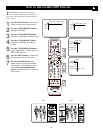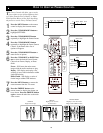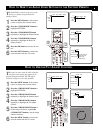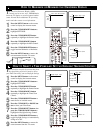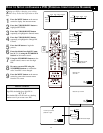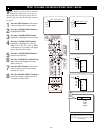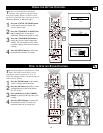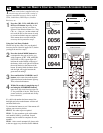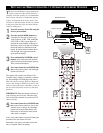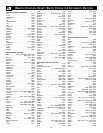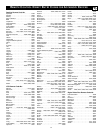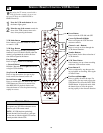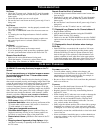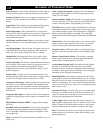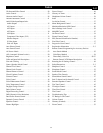
60
GLOSSARY OF TELEVISION TERMS
Active Control • Active Control continuously measures and cor-
rects the incoming signals to provide the best picture possible.
Alternate Channel • Allows you to toggle between the last two
channels viewed by pressing the A/CH button on the remote
control.
Aspect Ratio • The proportions of a rectangular display screen.
NTSC television has a 4:3 ratio; HDTV has a 16:9 ratio.
Audio/Video Inputs • Jacks (standard RCA), located on the
back of the TV, used for external accessory devices. These jacks
are designed to receive higher picture resolution and offer
sound-connection options.
Auto Picture and Auto Sound • Buttons on the remote control
(Sound and Picture) to select predefined picture and sound set-
tings.
Auto Programming • When activated, this feature scans for all
available channels from regular antenna or cable signals and
stores only active broadcast stations in the TV’s memory.
Channel Edit • The feature that allows you to add or delete
channels from the list of channels stored in the TV’s memory.
Closed Captioning • The broadcast standard feature that allows
you to read the voice content of television programs on the TV
screen. Designed to help the hearing impaired, Closed
Captioning shows dialogue and conversations while a TV pro-
gram is in progress.
Coaxial Cable • A single solid wire normally matched with a
metal plug (F-type) end connector that screws (or pushes) direct-
ly onto a 75-ohm input found on the television or VCR.
Component Video Inputs • Inputs that allow the separate recep-
tion of blue, red, and luminance signals. These inputs provide
the highest possible color and picture resolution in the playback
of digital signal-source material, such as the kind available from
DVD players.
Composite Video Input • An input in which all the components
required for displaying the onscreen image are combined in one
signal.
High-definition Television (HDTV) • High-resolution digital
television.
Incredible Stereo (or Surround) • False acoustic management
of the audio signal that produces a dramatic expansion of the
wall of sound that surrounds the listener and heightens overall
viewing pleasure.
Menu • An onscreen list of feature controls available for you to
adjust or set.
NTSC (analog video signals) • National Television Standards
Committee format devised to TV broadcasting signals in the
1940s (525 lines: 60Hz).
Onscreen Displays (OSD) • The wording or messages generat-
ed by the television (or VCR) to help you with specific feature
controls (color adjustment or programming, for example).
Pixel Plus improves picture quality and definition by increasing
the number of picture lines and the number of pixels per line to
give normal broadcast signals, DVD reproduction or Digital TV
signals, unparalleled sharpness and depth. Gives near High
Definition and natural looking detail without the High Definition
signal.
Picture Freeze • TV mode which allows you to freeze a certain
image in order to study a specific detail at ease, e.g. to make
notes of certain program information like phone numbers.
Progressive Scan • Double the number of visible picture lines
per field. A jitter-free and quiet picture with astonishing sharp-
ness.
Remote Control Sensor Window • The window or opening
found on the television control panel through which infrared
remote control command signals are received.
Second Audio Program (SAP) • An additional audio channel
provided for in the Multichannel Television Sound (MTS)
broadcast standard. A monaural soundtrack included within the
recorded or video signal (usually containing a second language
translation for the displayed programming).
Status/Exit Button • The remote control function that allows
you to quickly confirm what channel number you are watching.
Status/Exit can also be used to clear the television of onscreen
displays or information. You can use Status/Exit rather than hav-
ing to wait for the displays to “time out,” or automatically disap-
pear from the screen.
Surround Pro Logic • Literally wraps you in 4-channel sound.
It brings your favorite movies to life with all the realism and
impact of cinema sound as though you are part of the action or
viewing your programming from the theatre.
S-Video Input • Signal input that allows direct connection of
high-resolution video sources, such as a satellite receiver, DVD
player, S (Super)-VHS videocassette recorder, or video games.
Provides improved picture resolution, sharpness, and clarity.
Tint • TV function that allows you to change the general color
balance between cool and warm. Adjust tint according to your
personal preference.



